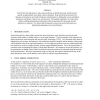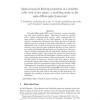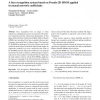171 search results - page 30 / 35 » Spike Trains in Spiking Neural P Systems |
NECO
2010
13 years 2 months ago
2010
Temporal derivatives are computed by a wide variety of neural circuits, but the problem of performing this computation accurately has received little theoretical study. Here we sy...
IJCNN
2000
IEEE
13 years 12 months ago
2000
IEEE
Neural Network approaches to time series prediction are briefly discussed, and the need to specify an appropriately sized input window identified. Relevant theoretical results fro...
ICONIP
2007
13 years 9 months ago
2007
We propose a technique to make a robot execute free and solitary dance movements on music, in a manner which simulates the dynamic alternations between synchronisation and autonomy...
JCNS
2006
13 years 7 months ago
2006
The spike-diffuse-spike (SDS) model describes a passive dendritic tree with active dendritic spines. Spine-head dynamics is modeled with a simple integrate-and-fire process, whils...
SOCO
2008
Springer
13 years 7 months ago
2008
Springer
Face recognition from an image or video sequences is emerging as an active research area with numerous commercial and law enforcement applications. In this paper different Pseudo 2...



